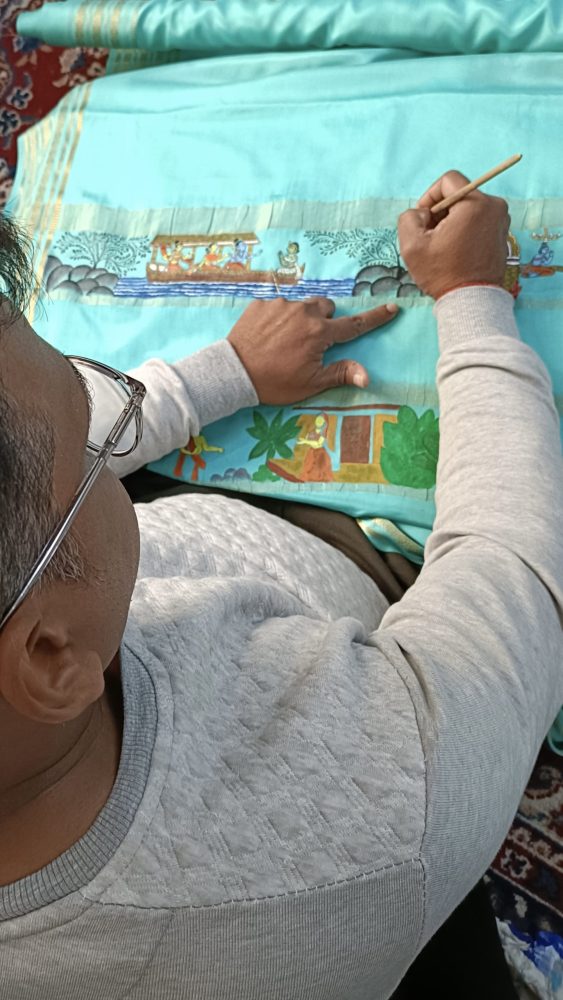The weaving or painting traditions of India gets more relevant when one considers them for appropriate occasions. Consider two such sarees of actors Alia Bhatt and Deepika Chikhlia whose drape stole the show at Ayodhya’s spiritual event on January 22.
Bengaluru: Crafts and weaving revival boutique Madhurya in South Bengaluru is not new to having celebrities wear its creations, as in the past well-known actors as Madhuri Dixit, Priyanka Chopra Athiya Shetty, Sara Ali Khan, Kangana Ranaut, Aishwarya Rajnikanth amongst several more have worn them for national and international events that also help bring in a focus on India’s treasured handloom heritage in silks.

What makes Madhurya’s weave for Bollywood stars Alia Bhatt and Deepika Chikhlia relevant now are the special drapes designed for Ayodhya’s Lord Rama consecration which the two wore for the sacred event. Says celebrity Stylist Ami Patel based out of Mumbai, “Both Alia and Deepika had their sarees – Mysore Silk for Alia and Kanjeevaram for Deepika – relatable with handmade craft adding to the glory of welcoming the Lord in Ayodhya. While Alia’s Mysore Silk in blue, the colour of eternity with Zari brought in miniature hand-paintings in the pallu in pattachitra style with one scene from every eight Kandavs of the Ramayana; Deepika Chikhlia (who played Sita for Ramanand Sagar’s popular Doordarshan ‘Ramayan’ serial) chose an orange Kanjeevaram silk for adding a ceremonial regal touch, matched with temple jewellery, along with her blouse embroidered with Shankh and Chakra.”
“Hundred hours have gone into making this traditional pattachitra hand-painting by Sujeet Behera on the Mysore silk that Alia wore,” says Bharathy Harish who heads Madhurya and led the team of designers. “Our concepts were passed on to hand-painting artists who worked on them. There is a fascinating story that led to the creation of Alia Bhatt’s Ramayana saree,” she says.

In miniature styles, intricate details depicted are scenes from each Kandav shown in three horizontal panels in between zari-strips on the pallu – the breaking of the Shiva-Dhanush, Dasharatha’s promise, in the boat with the devoted Guha, the golden deer in panchavati, crossing the Laxman rekha and Sita’s kidnap, the Ram-Setu in all glory, Hanuman offering the ring to Sita in Ashoka Vatika and Rama Pattabhishek.
The orange checked saree with butis that Deepika wore, was also complemented with a Kalamkari drape with scenes of the Ramayana painted by our traditional Kalamkari artist Shashibala in Kalahasti. “While our eye-to-detailing such historical events on a saree was to ensure valu e-add ons with our rich heritage to mark such historical occasions that make history, we are glad to have had prominent actors liking them and choosing to wear,” says Bharathy, adding that Madhurya supports 1100 weavers, and intervenes and participates in the designing process to have patterns and motifs revived for posterity, and supports education for the under-privileged all over India.
Grandeur of Mysore Silks
Mysore silk, renowned for its quality, lustre and elegance, are produced by Karnataka Silk Industries Corporation (KSIC) which holds a patent too. The Mysore silk factory was founded in 1912 by erstwhile Mysore Royal Nalvadi Krishnaraja Wadiyar. Then considered a royal fabric, it contains 65% pure silver and 0.65 % of gold. It comes in two varieties: crepe de chine & georgette.
In 2015 this heritage silk saree of Mysore was selected for Air India staff, and the home-grown silk manufacturer showcases nearly 500 designs and even sports a range from Rs.7000 to 2 lakh! With a thrust on quality the best of the cocoon silk is used for the sheen that has transcended boundaries.

Maintenance of Mysore silks include washing them by hand with a liquid detergent, or dry-cleaning them, as machine wash can damage the yarn, crumple the zari to spoil the lustre.
* Dry them in a shaded area, because direct sunlight may fade the natural colours used.
* Iron them with precaution upside-down, as the delicate silk fibres cannot take harsh heat.
* Wrap them in cotton cloth and store them away from sunlight
Heritage paintings on the sarees
Amongst the first-born and widespread art forms of Odisha,’Pattachitra’ has evolved from the Sanskrit words ‘patta’ (canvas) and ‘chitra’ (picture). It refers to a painting done on canvas and is manifested by rich colourful applications, creative motifs, and designs, portraying simple themes, mostly mythological in depiction. All colours used are natural and with Pattachitra being a disciplined art form, the chitrakars are rooted and firm in their use of colours and patterns.

Kalamkari originated in the modern-day states of Andhra Pradesh and Telangana several hundred years ago. It was first used to portray scenes from sacred texts such as the Mahabharata, Ramayana and Bhagavatam. These paintings were often displayed as decorative backdrops in temples, depicting the stories of deities. Deriving its name from the word ‘kalam,’ which means pen, ‘Kalamkari’ refers to a particular, intricate style of hand-painting onto cloth. There are two types of Kalamkari painting: Srikalahasti, which is the freehand drawing style, and Machilipatnam, which is the block-printing technique















